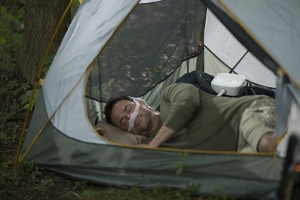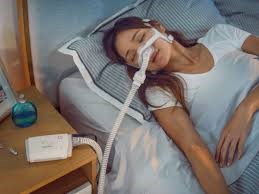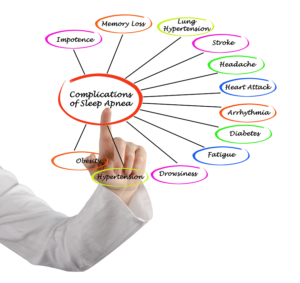CPAP and COVID-19
10 Things You Need to Know CPAP and COVID-19
We are receiving a lot of questions about CPAP use during the COVID-19 Pandemic. Comprehensive Sleep Care Center is here to help you with this, and all your sleep care needs. That includes the use of CPAP (Continuous Positive Airway Pressure) as well as BiPAP and ASV Therapy during the COVID-19 Coronavirus Pandemic.
First and foremost, the most important thing we can tell you is DO NOT STOP USING YOUR CPAP without first speaking to your doctor! You were prescribed a CPAP for a medical reason and stopping can put your health at risk.
The information below is for educational use only. If you need specific medical advice, please call the office to speak to the physician or DME-Durable Medical Equipment representative.
Do I have a higher risk of getting coronavirus because I have sleep apnea?
- There is no evidence linking sleep apnea with coronavirus risk.
If I do have the coronavirus, will CPAP help me treat it?
- Your CPAP is used to treat one thing, your obstructive sleep apnea.
- The question becomes, if you Do Not use your CPAP, what could happen? We know that we want to stay healthy. Well good quality sleep is needed to do that. If you’re not using your CPAP, you’re going to further weaken your immune system. And if you do have coronavirus, or you’re worried about getting coronavirus or any virus, you’re going to be more susceptible if you stop using your device.
What’s the Difference Between CPAP Machines and Ventilators?
- CPAP machines and ventilators are both considered mechanical ventilation. They both assist with a patient’s breathing. But there is a big difference -CPAP machines deliver a steady stream of pressurized air to keep the airways open while sleeping, thus preventing the collapse of the passageway and episodes of interrupted breathing. A ventilator is necessary for more severe respiratory conditions in which a patient is unable to breath on their own. A ventilator requires a tube being medically inserted. If you’re using a CPAP machine because you’re in respiratory distress due to COVID-19 infection, you need to call talk to your primary care or go to the emergency room.
If I have symptoms or have tested positive for Coronavirus, should I continue using my CPAP?
- Coronavirus doesn’t change your sleep apnea diagnosis – or your need to continue using CPAP therapy. You should continue to use your CPAP machine because a full night’s sleep benefits your overall health.
- If you have symptoms of the coronavirus, you should isolate yourself in a separate bedroom and use a separate bathroom, if available. In this “recovery room,” you can continue to use CPAP while you sleep alone.
- In the event of COVID-19 diagnosis, it is important to continue the cleaning guidelines provided for your unit. Please refer to our web page for step-by-step instructions on cleaning your device and mask.
- We recommend increasing the weekly cleaning to a minimum of bi-weekly during an active infection.
- After you are free from the coronavirus, replace your CPAP filters and disposable accessories as soon as possible.
Can my CPAP machine spread Coronavirus to my bed partner?
- The latest information says non-invasive ventilation (delivered by a mask with air diffusers) has a low risk of aerosolization, provided that there is a good mask fit, and you follow patient isolation (recovery room) guidelines.
Will my insurance still request compliance while in the Pandemic?
- This is a bit tricky. Insurance companies have not provided any information to indicate that there are any changes to the compliance requirements. If there are extenuating circumstances for a patient, inform your doctor immediately so they can document the information. But it will not ensure that if compliance is requested the extenuating circumstances will override the compliance requirements.
How often should I clean and disinfect my CPAP mask and hose?
- It’s important to clean your equipment as specified in the instructions for use that came with your equipment. Poor or inappropriate maintenance can make your sleep therapy ineffective and damage your equipment.
- If you’ve been sick, it’s smart to wash your mask, tubing, humidifier and filter daily until your cold, flu or virus symptoms are gone. That can help reduce the amount of time you spend feeling under the weather.
- To be cautious in this time of COVID-19, we recommend increasing the weekly cleaning to bi-weekly cleaning.
- Keeping it clean: CPAP hygiene
- Replace your mask and other equipment to keep your machine clean and functioning optimally. We recommend you replace your mask/supplies every 90 days as allowed by your insurance carrier.
Distilled water is unavailable in my area. What should I use in my CPAP humidifier?
- Optimal humidifier performance requires distilled water. That’s because most or all its minerals have been removed, preventing mineral buildup in the humidifier tub. That said, bottled (purified) water may also be used. It will not harm the device or pose a risk to patients. It will, however, require more rigorous humidifier cleaning to prevent excess mineral buildup in the tub.
Will a CPAP cleaning machine disinfect my CPAP device and mask?
- No, CPAP cleaning machines are not FDA-approved and especially right now, I would say, soap and water are still your best option to effectively clean your device.
Are there any additives or chemicals that I should use to clean a CPAP machine during the coronavirus outbreak?
- The answer is NO!
- During a time like this, people may be tempted to try different things like bleach or other chemicals in their CPAP machine. But remember these chemicals can get in your lungs and cause damage. Please, just stick to what’s recommended. Don’t add anything else.
CPAP Cleaning Instructions
Daily Cleaning
**Do not use moisturizing soaps, bleach, scented oils, chlorine, or alcohol-based solutions to clean your supplies. These solutions may cause irritation to your skin and lungs and may reduce the life of your products.
**If you’ve been sick, it’s smart to wash your mask, tubing, humidifier and filter daily until your cold, flu or virus symptoms are gone. That can help reduce the amount of time you spend under the weather.
- Before using your mask -wash your face daily with soap and water to remove excess facial oils.
- Wipe down your mask (including areas that come in contact with your skin) using a damp towel with soap and warm water. This will remove any oils, dead skin cells, and sweat on the mask that can affect the quality of the seal. Gently rinse with a clean towel and let the mask air-dry out of direct sunlight.
- **You can also use unscented baby wipes or pre-moistened towels designed specifically for cleaning CPAP masks, which are available on-line. DO NOT USE CLOROX OR DISINFECTING WIPES.
- If your unit has a humidifier, empty any leftover water instead of letting in sit in the unit all day. Refill the humidifier with clean, distilled water right before bedtime for optimal use
Weekly (more more frequent) Cleaning
- Your mask and tubing need a full bath at once a week to keep it free of dust, bacteria, and germs. (During COVID-19 or any other virus we recommend more frequent cleaning)
- Clean the CPAP tubing, nasal mask, and headgear in a bathroom sink filled with warm water and a few drops of ammonia-free, mild dish detergent. Avoid using stronger cleaning products, including dish detergents, as they may damage the mask or leave harmful residue. Swirl all parts around for about five minutes, rinse well and let air dry during the day. Hang the tubing over the shower rod, on a towel rack or in the laundry room to ensure all the water drips out.
- The mask and headgear can be air-dried on a towel or hung on a hook or hanger.
- You should also wipe down your CPAP machine with a damp cloth. Ensure the unit is unplugged. The towel shouldn’t be too damp or wet, as water could get into the machine.
- Clean the filter by removing it and rinsing it in warm tap water. Run it under the water and squeeze to make sure there is no dust. Then blot down the filter with a towel.
- Do not wash your machine’s white filter, if one is present—those are disposable and should be replaced every two weeks. If you are recovering from being sick, we recommend changing the filter sooner.
- If your CPAP has a humidifier, that also needs to be cleaned weekly.
- Empty any remaining water and then wash the water chamber in the sink with warm soapy water. Rinse well and drain out as much of the water as possible. Let the chamber air-dry before placing it back into the CPAP unit.
- Every other week you should disinfect the humidifier. Do that by soaking it in a solution of one-part vinegar to five parts water for 30 minutes, thoroughly rinsing and then placing in your dishwasher’s top rack for washing. And keep it clean by using only distilled water to prevent mineral deposits that can build up and cause damage to your machine.
**The following are examples of soap that may be used: Johnson & Johnson baby soap, Ivory soap (plain).
With a little upkeep, your CPAP can continue to help you breathe better for a long time. Just a few minutes a day can help keep your CPAP running efficiently for years to come.
Stay Healthy and Stay Strong!




